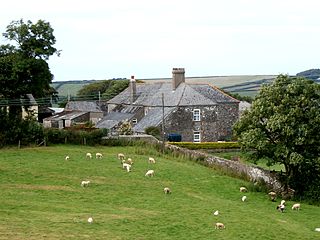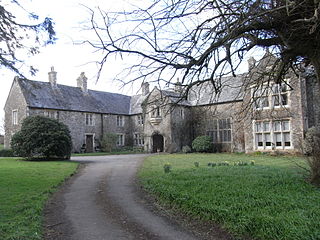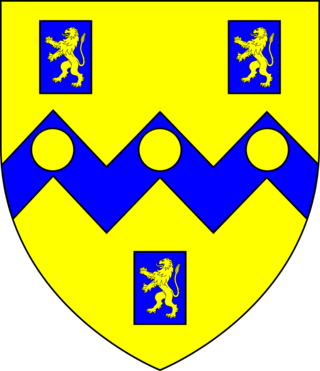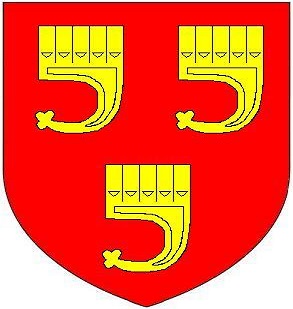
Halsbury is a historic manor in the parish of Parkham in North Devon, England. It is situated 2 miles north-east of the village of Parkham and 4 miles south-west of the town of Bideford. Halsbury was long a seat of the ancient Giffard family, a distant descendant of which was the celebrated lawyer Hardinge Stanley Giffard, 1st Earl of Halsbury (1823–1921), who adopted the name Halsbury for his earldom and was the author of the essential legal reference books Halsbury's Statutes. Halsbury Barton, now a farmhouse, retains 16th- and 17th-century elements of the former manor house of the Giffard family. It was described in a record of 1560 as a "new dwelling house".

Sock Dennis is an historic manor in the parish of Ilchester in Somerset, England.

Bicton House, or Bickton House, is a late 18th- or early 19th-century country house, which stands on the campus of Bicton College, Bicton, near Exmouth, East Devon. It is a Grade II* listed building. The park and gardens are Grade I listed in the National Register of Historic Parks and Gardens.
Ilchester Nunnery, in Ilchester, Somerset, England, was founded around 1217-1220 as the "White Hall Hospital of the Holy Trinity", after the gift of a house and other property by William "The Dane" of Sock Dennis manor, Ilchester. From this family was probably descended the influential Denys family of Devon, seated at Orleigh in the 16th century. By 1281, it had been converted into an Augustinian nunnery.
John Lee Lee of Orleigh Court in the parish of Buckland Brewer in Devon, and of Dillington House, near Ilminster in Somerset, was a British Whig politician who was Member of Parliament for Wells in Somerset between 1830 and 1837. He was Sheriff of Somerset in 1845–6.

Orleigh Court is a late medieval manor house in the parish of Buckland Brewer about 4 miles south-west of Bideford, North Devon, England. It is a two-storeyed building constructed from local slate stone and has a great hall with a hammer-beam roof, installed in the late 15th century.

Weare Giffard is a small village, civil parish and former manor in the Torridge district, in north Devon. The church and manor house are situated 2 1/2 miles NW of Great Torrington in Devon. Most of the houses within the parish are situated some 1/2-mile east of the church. The church is situated on a hillside to the north and slightly above the wide and flat valley floor of the River Torridge. The Church of the Holy Trinity and the adjacent Weare Giffard Hall are designated members of the Grade I listed buildings in Devon.

Holcombe Burnell is a civil parish in Devon, England, the church of which is about 4 miles west of Exeter City centre. There is no village clustered around the church, rather the nearest village within the parish is Longdown. Only the manor house and two cottages are situated next to the church. The former manor house next to the church is today known as Holcombe Burnell Barton having subsequently been used as a farmhouse. The manor was in the historical Hundred of Wonford.

Collaton St Mary is a village, parish and former manor in Devon, England, situated about 2 miles (3 km) west of the town of Paignton. The village is bisected by the A385 Paignton to Totnes road. The parish is now administered within the unitary authority of Torbay, Devon.
The Denys family of Siston, also spelled Dennis, originally came from Glamorgan in Wales and in the late 14th century acquired by marriage the manor of Siston, Gloucester and shortly thereafter the adjoining manor of Dyrham. Maurice Denys re-built Siston Court in the 16th century.

Sir Robert Dennis, JP of Holcombe Burnell in Devon, was a Member of Parliament for Devon in 1555 and served as Sheriff of Devon.

John Rolle (1522–1570) of Stevenstone, in the parish of St Giles in the Wood, near Great Torrington, Devon, was the eldest son and heir of George Rolle, MP, founder of the great Rolle family of Stevenstone, by his second wife Eleanor Dacres. Three monuments survive in memory of his immediate family in the churches of St Giles in the Wood and Chittlehampton.

Potheridge is a former Domesday Book estate in the parish of Merton, in the historic hundred of Shebbear, 3 miles south-east of Great Torrington, Devon, England. It is the site of a former grand mansion house re-built by George Monck, 1st Duke of Albemarle (1608–1670) circa 1660 on the site of the former manor house occupied by his family since at the latest 1287. It was mostly demolished in 1734 after the death of the widow of his son Christopher Monck, 2nd Duke of Albemarle.

Denys Rolle (1614–1638) of Bicton and Stevenstone in Devon was Sheriff of Devon in 1636. He was one of the biographer John Prince's Worthies of Devon.

Orleigh is a historic manor in the parish of Buckland Brewer, situated 4 miles to the south west of Bideford, North Devon, England. The manor house is known as Orleigh Court.

The manor of Bideford in North Devon was held by the Grenville family between the 12th and 18th centuries. The full descent is as follows:

The Manor of Poltimore is a former manor in Devon, England. The manor house known as Poltimore House survives in its 18th-century remodelled form, but has been dilapidated for several decades. A charity named the "Poltimore House Trust" has been established for the purpose of its restoration. The manor was situated within the historic Wonford Hundred and was largely coterminous with the parish of Poltimore and contained the village of Poltimore, 4 miles (6.4 km) north-east of the historic centre of the City of Exeter. It should not be confused with the eponymous Devon estate of Poltimore in the parish of Farway, 16 miles (26 km) east of Exeter. Poltimore was the principal seat of the Bampfylde family from c. 1300 to 1920.
The Manor of Bicton is an historic manor in the parish of Bicton in east Devon, England.

Weycroft is an historic manor in the parish of Axminster in Devon, England. The surviving manor house known as "Weycroft Hall" is a Grade I listed building which includes elements from the 15th, 16th and 17th centuries, with a great hall of circa 1400, and was restored in the 19th century.

Brooke in the parish of Ilchester in Somerset, England, was an historic estate, the earliest known seat of the prominent Brooke family, Barons Cobham.














